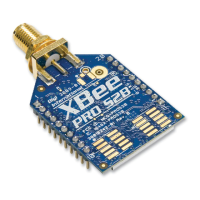Network commissioning and diagnostics Device discovery
XBee/XBee-PRO ZigBee RF Modules User Guide 84
Send an Explicit Addressing ZigBee Command API frame (0x11) using 0x12 as the cluster ID, 0xC105 as the Profile
ID, and 0xE8 as the source and destination endpoint. Data packets received by the remote will be echoed back to
the sender.
RSSI indicators
It is possible to measure the received signal strength on a device using the DB command. DB returns the RSSI
value (measured in –dBm) of the last received packet. However, this number can be misleading. The DB value
only indicates the received signal strength of the last hop. If a transmission spans multiple hops, the DB value
provides no indication of the overall transmission path, or the quality of the worst link – it only indicates the
quality of the last link and should be used sparingly.
The DB value can be determined in hardware using the RSSI/PWM module pin (pin 6). If the RSSI PWM
functionality is enabled (P0 command), when the module receives data, the RSSI PWM is set to a value based on
the RSSI of the received packet. Again, this value only indicates the quality of the last hop. This pin could
potentially be connected to an LED to indicate if the link is stable or not.
Device discovery
Network discovery
The network discovery command can be used to discover all Digi modules that have joined a network. Issuing the
ND command sends a broadcast node discovery command throughout the network. All devices that receive the
command will send a response that includes the device’s addressing information, node identifier string (see the
NI command), and other relevant information. This command is useful for generating a list of all module
addresses in a network.
When a device receives the node discovery command, it waits a random time before sending its own response.
The maximum time delay is set on the ND sender with the NT command. The ND originator includes its NT setting
in the transmission to provide a delay window for all devices in the network. Large networks may need to
increase NT to improve network discovery reliability. The default NT value is 0x3C (six seconds).
ZDO discovery
The ZigBee Device Profile includes provisions to discover devices in a network that are supported on all ZigBee
devices (including non-Digi products). These include the LQI Request (cluster ID 0x0031) and the Network Update
Request (cluster ID 0x0038). The LQI Request can be used to read the devices in the neighbor table of a remote
device, and the Network Update Request can be used to have a remote device do an active scan to discover all
nearby ZigBee devices. Both of these ZDO commands can be sent using the XBee Explicit API transmit frame
(0x11). See API operation on page 108 for details. Refer to the ZigBee specification for formatting details of these
two ZDO frames.
Joining announce
All ZigBee devices send a ZDO Device Announce broadcast transmission when they join a ZigBee network (ZDO
cluster ID 0x0013). These frames will be sent out the XBee's UART as an Explicit Rx Indicator API frame (0x91) if AO
is set to 1. The device announce payload includes the following information:
[sequence number] + [16-bit address] + [64-bit address] + [capability]
The 16-bit and 64-bit addresses are received in little-endian byte order (LSB first). See the ZigBee specification for
details.

